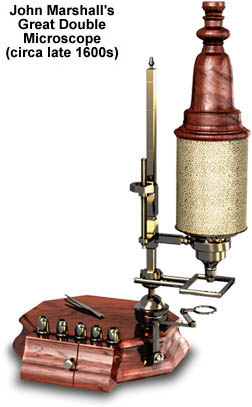John Marshall's
Great Double Microscope
John Marshall created this intricately detailed compound microscope at the end seventeenth century and popularized it by publishing an advertisement in the Lexicon Techinicum, the first technical dictionary published in 1704. At least fifteen genuine Great Double microscopes have survived, which allowed historians and scientists to more accurately describe the characteristics of this handsome microscope.

Marshall called his microscope the Great Double microscope for two reasons: he wanted to illustrate the large size of the microscope and to reinforce the fact that it was a compound microscope. The microscope, as a whole, bore a great resemblance to Hooke's microscope. Hooke and Marshall both used a ball and socket as a pivot for the microscopes, but the Marshall design utilized the pivot primarily for inclination (up to 45 degrees from vertical) of the body tube. The stage was connected directly to the limb of the microscope and beneath the objective, a great improvement over the Hooke model which had to be re-adjusted whenever the inclination was changed. A ball and socket connector was used to fasten the microscope limb to an finely-crafted octagonal wooden base that was weighted with lead at the opposite end to balance the microscope. Inside the wooden base was a drawer, which served to carry spare parts, objectives, and additional microscope accessories.
One of the most significant features of Marshall's microscope was the fine focus mechanism, which was a very unique design element for the period. The mechanism functioned through a series of sleeves that attached the microscope body to the limb. One sleeve served to attach and adjust the position of the body tube to the limb, while the other moved the body tube up and down with a small focusing knob. Another interesting feature of this microscope is the transmitted light focusing lens (not shown) that allowed the microscope to use transmitted light from a candle or other source. The microscope stage had a glass insert for use with transmitted light and a solid brass insert that was intended for reflected light observations. The stage was secured to the limb by means of two forked legs that were adjusted by a small nut, positioned just above the ball and socket assembly.
Marshall provided his microscopes with an average of six interchangeable objectives having a magnification range of 4x to about 100x. In later models, he provided a revolving nosepiece that held multiple objectives, similar to modern microscopes.
BACK TO SIXTEENTH-SEVENTEENTH CENTURY MICROSCOPES
